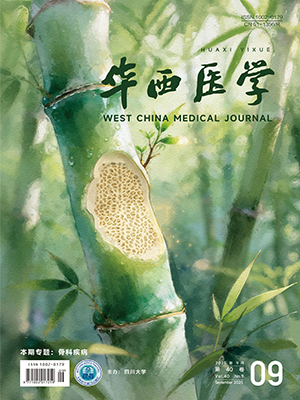Objective To observe the effect of “Luo’s Roujin Technique” on the inflammatory response and joint capsule fibrosis in white rabbits with scapulohumeral periarthritis model. Methods Thirty healthy male New Zealand white rabbits were randomly divided into a control group, a model group, and a treatment group, with 10 rabbits in each group. Scapulohumeral periarthritis models were established in the model group and the treatment group, while the control group received identical restraint procedures at the same timepoints. Six rabbits in the model group and seven in the treatment group were successfully modeled. The subsequent experiment included all six successfully modeled rabbits from the model group, along with six rabbits randomly selected from each of the control and treatment groups. On the second day after successful modeling, blood samples were collected from the auricular marginal vein in all three groups. After blood collection, the treatment group began massage therapy for 21 consecutive days, while the other two groups underwent the same restraint procedure simultaneously. On Day 22, all the three groups were euthanized after blood collection from the auricular marginal vein, and the synovial tissue of the affected shoulder joint was completely collected. Hematoxylin-eosin staining was used to examine the histopathological features of the synovial tissue. Enzyme-linked immunosorbent assay was employed to measure the concentrations of interleukin (IL)-1β, IL-6, IL-17, and tumor necrosis factor-α (TNF-α). Western blot and reverse transcription polymerase chain reaction were used to assess the protein and mRNA expression levels of vascular endothelial growth factor (VEGF), connective tissue growth factor (CTGF), transforming growth factor-β1 (TGF-β1), and Smad3. Results After treatment, the control group showed no significant inflammatory cell infiltration or fibrous tissue proliferation in the synovial tissue. The model group exhibited synovial cell hyperplasia in the lining layer and inflammatory cell infiltration in the sublining layer. The treatment group displayed mild inflammatory cell infiltration in the sublining layer. Compared with the control group, the model group showed significantly increased concentrations of IL-1β, IL-6, IL-17, and TNF-α in both serum and synovial homogenate, as well as elevated protein and mRNA expression of VEGF, CTGF, TGF-β1, and Smad3 in synovial tissue (P<0.05). Compared with the model group, the treatment group exhibited significantly lower serum levels of IL-1β, IL-6, and TNF-α, as well as reduced synovial homogenate levels of IL-1β, IL-6, IL-17, and TNF-α (P<0.05); furthermore, protein expression of VEGF, CTGF, TGF-β1, and Smad3 and mRNA expression of VEGF and CTGF in synovial tissue were significantly decreased in the treatment group (P<0.05). Conclusions “Luo’s Roujin Technique” can significantly alleviate local inflammatory infiltration in the synovial tissue of rabbits with scapulohumeral periarthritis, and reduce the levels of IL-1β, IL-6, IL-17, and TNF-α in both serum and synovial tissue. The underlying mechanism may involve suppression of VEGF, CTGF, TGF-β1, and Smad3 expression, leading to attenuated inflammatory responses and inhibition of fibroblast-to-myofibroblast transition. Thereby, it mitigates fibrotic changes in the shoulder joint capsule, exerting anti-inflammatory and analgesic effects and improving joint mobility.
Citation:
XU Yao, LÜ Xiaofeng, XIE Bing, LU Qunwen, LUO Jian. Effect of “Luo’s Roujin Technique” on inflammatory response and joint capsule fibrosis in rabbits with scapulohumeral periarthritis model. West China Medical Journal, 2025, 40(9): 1402-1409. doi: 10.7507/1002-0179.202502071
Copy
Copyright © the editorial department of West China Medical Journal of West China Medical Publisher. All rights reserved




